Understanding the Essential Role of Caster Wheels in Mobility Systems
Caster wheels are an integral component in numerous industries and everyday applications, from hospital beds and office chairs to industrial machinery and heavy-duty carts. These versatile components provide movement and maneuverability to otherwise stationary objects, making transportation and mobility much more efficient. When selecting the right type of caster wheels for a specific use case, understanding the fundamental differences between fixed and swivel caster wheels is crucial.
Each caster wheel type offers unique benefits and potential drawbacks, depending on the context of use. Fixed caster wheels are designed to move in a straight line and offer greater stability and load-bearing capacity. On the other hand, swivel caster wheels allow for 360-degree rotation, granting greater maneuverability and control. Choosing between fixed and swivel caster wheels can significantly impact operational efficiency, safety, and ease of use.
Key Characteristics of Fixed Caster Wheels
Straight-Line Mobility and Enhanced Stability
Fixed caster wheels, also known as rigid casters, are ideal for applications requiring linear movement. These caster wheels do not swivel, which means they only move forward and backward along a fixed path. This quality makes fixed caster wheels perfect for environments where directional control is essential, such as in factory lines or material handling carts.
Because of their straightforward design, fixed caster wheels offer enhanced stability. When used in tandem with swivel caster wheels, they help maintain a controlled direction, especially in long-distance or repetitive movement scenarios.
Higher Load Capacity and Durability
Another significant advantage of fixed caster wheels is their ability to handle heavier loads. With fewer moving parts, these caster wheels can bear more weight without compromising on performance. This makes them particularly suitable for industrial applications where robustness and reliability are critical.
Their simple structure also means fixed caster wheels are less prone to wear and tear. Fewer moving parts translate to reduced maintenance and longer service life, further increasing their appeal in heavy-duty settings.

Features and Advantages of Swivel Caster Wheels
360-Degree Rotation and Superior Maneuverability
Swivel caster wheels are designed to rotate freely around a vertical axis, allowing objects to move in multiple directions with ease. This feature is especially valuable in tight spaces or environments that require frequent changes in direction.
These caster wheels are commonly found on items like office chairs, hospital beds, and carts used in retail and hospitality sectors. The flexibility they offer makes them indispensable in applications where navigation and control are paramount.
Versatility in Various Environments
One of the most notable strengths of swivel caster wheels is their versatility. Whether used in commercial settings or residential spaces, these caster wheels can adapt to different floor types, weight requirements, and operational needs.
Swivel caster wheels come in various materials and sizes, providing users with numerous customization options. From rubber and polyurethane to steel and nylon, the material choice can influence the caster wheel’s noise levels, floor protection, and resistance to environmental factors.
Choosing the Right Caster Wheel for Your Application
Load Requirements and Operational Conditions
Before selecting between fixed and swivel caster wheels, it's essential to assess the load requirements of your application. Swivel caster wheels are ideal for lighter loads that require high mobility, whereas fixed caster wheels excel under heavier loads that demand stability.
Consider the environmental conditions as well. If the caster wheels will be exposed to moisture, chemicals, or extreme temperatures, the material composition becomes a critical factor. Some caster wheels are designed to resist corrosion or provide heat resistance, making them more suitable for specific industries.
Movement Pattern and Space Constraints
Understanding the movement pattern of the equipment is key. For example, if your workspace involves tight corners or narrow aisles, swivel caster wheels offer the agility needed for efficient navigation. Conversely, fixed caster wheels are more appropriate for straight-path movement over longer distances.
In many cases, combining fixed and swivel caster wheels provides the best of both worlds. A common setup involves placing fixed caster wheels at the rear and swivel caster wheels at the front, striking a balance between maneuverability and directional control.
Maintenance and Lifespan Considerations
Inspection and Regular Servicing
Regardless of the caster wheel type, regular maintenance is crucial for ensuring optimal performance and longevity. Routine inspection of caster wheels for signs of wear, such as cracks, flat spots, or loosened components, can prevent accidents and equipment failure.
Both fixed and swivel caster wheels benefit from periodic lubrication, particularly in high-use environments. Ensuring that wheels rotate smoothly and that bearings are free of debris will extend their service life significantly.
Replacement and Downtime Minimization
Over time, even the most durable caster wheels will require replacement. Knowing when to replace caster wheels is vital to avoid unexpected downtime. Signs such as uneven rolling, noise during operation, or visible structural damage are indicators that it's time for a change.
Choosing high-quality caster wheels from the outset and implementing a proactive maintenance schedule can minimize replacement frequency and operational disruptions.
Material Composition and Floor Compatibility
Impact on Surface Types
The type of material used in caster wheels directly affects floor compatibility and wear. Harder materials like steel or nylon can damage delicate surfaces, while softer materials like rubber or polyurethane offer better shock absorption and floor protection.
For facilities with sensitive flooring, such as hospitals or office buildings, selecting the appropriate caster wheels can prevent costly floor repairs and enhance user comfort.
Noise Reduction and Shock Absorption
Caster wheels can also contribute to noise levels in a workspace. Swivel caster wheels made from rubber or polyurethane are often quieter than those made from harder materials. This makes them ideal for noise-sensitive environments like libraries or medical facilities.
Shock absorption is another important factor, particularly in transporting fragile goods. Caster wheels with built-in suspension or softer tread materials help cushion the impact, reducing the risk of damage during movement.
Industry-Specific Applications and Use Cases
Healthcare and Hospitality
In healthcare and hospitality settings, maneuverability and noise reduction are top priorities. Swivel caster wheels excel in these environments, allowing staff to navigate tight corridors and busy rooms without disturbing patients or guests.
Caster wheels used in these industries must also meet hygiene and cleanliness standards. Smooth surfaces and corrosion-resistant materials are often preferred to facilitate cleaning and prevent contamination.
Manufacturing and Warehousing
For manufacturing and warehousing, fixed caster wheels are often the go-to choice due to their durability and high load-bearing capacity. These caster wheels are designed to withstand the rigors of heavy use and can be customized for specific floor conditions.
In some cases, a hybrid configuration using both fixed and swivel caster wheels allows for increased flexibility without sacrificing strength. This setup can improve workflow and reduce the risk of workplace accidents.
Ergonomics and Worker Safety
Reducing Physical Strain
Proper caster wheel selection can significantly affect ergonomics and worker safety. Swivel caster wheels reduce the effort needed to maneuver equipment, thereby lowering the risk of strain and injury. This is especially important in roles involving repetitive movement or heavy loads.
Fixed caster wheels contribute by keeping movement predictable, reducing the likelihood of sudden directional changes that can cause accidents or tip-overs.
Compliance with Safety Regulations
Many industries are subject to strict occupational health and safety regulations. Choosing the right caster wheels helps ensure compliance with these standards, supporting a safer and more efficient working environment.
Caster wheels equipped with locking mechanisms or brakes offer added control, especially in situations where stability during stationary periods is crucial.
Cost Efficiency and Long-Term Value
Initial Investment vs. Long-Term Performance
While the upfront cost of caster wheels can vary, focusing on long-term performance and reliability is key to maximizing return on investment. High-quality caster wheels reduce maintenance costs, minimize downtime, and enhance operational efficiency.
Swivel caster wheels may come at a higher initial price due to their complexity, but their contribution to productivity and reduced labor strain often justifies the cost.
Customization and Scalability
As businesses grow and operational needs evolve, the ability to customize caster wheels becomes increasingly important. Whether you need different wheel diameters, braking systems, or tread materials, modern caster wheel solutions offer a wide range of scalable options.
Investing in customizable caster wheels ensures that your equipment remains adaptable, reducing the need for frequent replacements or upgrades.
FAQ
What are the main differences between fixed and swivel caster wheels?
Fixed caster wheels move in a straight line and offer greater load stability, while swivel caster wheels can rotate 360 degrees for improved maneuverability.
Can I use both fixed and swivel caster wheels on the same equipment?
Yes, combining both types of caster wheels is common. This setup offers directional control from the fixed wheels and flexibility from the swivel wheels.
How do I maintain caster wheels to ensure longevity?
Regular inspection, cleaning, and lubrication help extend the life of caster wheels. Replace damaged or worn wheels promptly to maintain performance and safety.
Table of Contents
- Understanding the Essential Role of Caster Wheels in Mobility Systems
- Key Characteristics of Fixed Caster Wheels
- Features and Advantages of Swivel Caster Wheels
- Choosing the Right Caster Wheel for Your Application
- Maintenance and Lifespan Considerations
- Material Composition and Floor Compatibility
- Industry-Specific Applications and Use Cases
- Ergonomics and Worker Safety
- Cost Efficiency and Long-Term Value
- FAQ

